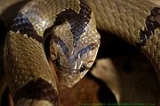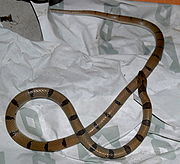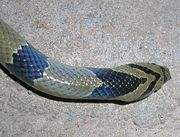
Oligodon arnensis
Encyclopedia
Common kukri snake or Banded kukri Oligodon arnensis is a species of nonvenomous snake
found in Sri Lanka
, India
, Pakistan
and Nepal
.
The following description is from Boulenger (1890) and Smith (1943).
 Nasal divided; portion of rostral seen from above as long as its distance from the frontal or a little shorter; suture between the internasals usually nearly as long as that between the prefrontals; frontal as long as its distance from the end of the snout or a little shorter, and a little shorter than the parietals; loreal, if distinct, longer than deep, frequently united with the prefrontal; preocular single; two postoculars; temporals 1+2; upper labials 7, third and fourth entering the eye; 4 lower labials in contact with the anterior chin-shields; posterior chin-shields one half or two thirds the length of the anterior. Scales in 17 rows. Ventrals angulate laterally, 170-202; anal divided; subcaudals 41-59. Pale brown or orange above, with well-defined black cross-bands, which vary in number and in width according to individuals, and may be edged with white; an angular or transverse black band between the eyes, another behind, with the apex on the frontal, and a third on the nape. Lower surface uniform yellowish, rarely spotted with brown or with a brown posterior border to the ventrals.(Smith, 1943:p. 226)
Nasal divided; portion of rostral seen from above as long as its distance from the frontal or a little shorter; suture between the internasals usually nearly as long as that between the prefrontals; frontal as long as its distance from the end of the snout or a little shorter, and a little shorter than the parietals; loreal, if distinct, longer than deep, frequently united with the prefrontal; preocular single; two postoculars; temporals 1+2; upper labials 7, third and fourth entering the eye; 4 lower labials in contact with the anterior chin-shields; posterior chin-shields one half or two thirds the length of the anterior. Scales in 17 rows. Ventrals angulate laterally, 170-202; anal divided; subcaudals 41-59. Pale brown or orange above, with well-defined black cross-bands, which vary in number and in width according to individuals, and may be edged with white; an angular or transverse black band between the eyes, another behind, with the apex on the frontal, and a third on the nape. Lower surface uniform yellowish, rarely spotted with brown or with a brown posterior border to the ventrals.(Smith, 1943:p. 226)
Total length 24 inches; tail 3.5 inches. (female 640mm, tail 100mm)

Habitat: India and Ceylon, northwards to Nepal and the Himalayas, where it has been recorded from an altitude of 4100 feet.

found in Sri Lanka
Sri Lanka
Sri Lanka, officially the Democratic Socialist Republic of Sri Lanka is a country off the southern coast of the Indian subcontinent. Known until 1972 as Ceylon , Sri Lanka is an island surrounded by the Indian Ocean, the Gulf of Mannar and the Palk Strait, and lies in the vicinity of India and the...
, India
India
India , officially the Republic of India , is a country in South Asia. It is the seventh-largest country by geographical area, the second-most populous country with over 1.2 billion people, and the most populous democracy in the world...
, Pakistan
Pakistan
Pakistan , officially the Islamic Republic of Pakistan is a sovereign state in South Asia. It has a coastline along the Arabian Sea and the Gulf of Oman in the south and is bordered by Afghanistan and Iran in the west, India in the east and China in the far northeast. In the north, Tajikistan...
and Nepal
Nepal
Nepal , officially the Federal Democratic Republic of Nepal, is a landlocked sovereign state located in South Asia. It is located in the Himalayas and bordered to the north by the People's Republic of China, and to the south, east, and west by the Republic of India...
.
Description
- See snake scalesSnake scalesSnakes, like other reptiles, have a skin covered in scales. Snakes are entirely covered with scales or scutes of various shapes and sizes. Scales protect the body of the snake, aid it in locomotion, allow moisture to be retained within, alter the surface characteristics such as roughness to aid in...
for terms used
The following description is from Boulenger (1890) and Smith (1943).

Total length 24 inches; tail 3.5 inches. (female 640mm, tail 100mm)

Habitat: India and Ceylon, northwards to Nepal and the Himalayas, where it has been recorded from an altitude of 4100 feet.

External links
- http://itgmv1.fzk.de/www/itg/uetz/herp/photos/Oligodon_arnensis.jpg
- http://itgmv1.fzk.de/www/itg/uetz/herp/photos/Oligodon_arnensis2.jpg

